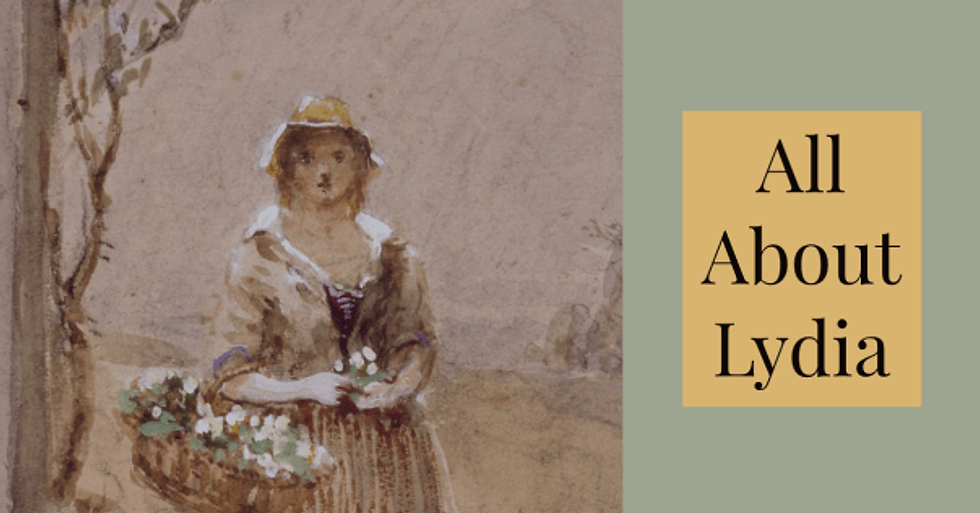Another look at Lydia Bennet
- Brett Harris
- May 27, 2020
- 3 min read
Updated: Aug 31, 2020

When it comes to irritating Austen characters, Lydia Bennet is certainly high on the list. Trampling her own reputation and flaunting her disregard for that of her sisters, Lydia is the selfish younger sister that we never wanted. Readers aren’t alone in this sentiment: a recent article from “The Guardian” suggests that Austen’s inspiration for the character arose from an undesirable sister-in-law. According to the article, Mary Pearson, the alleged archetype for Lydia, was deemed an unlikely match for Austen’s brother, Henry— a prediction that came true after only a few months of their engagement. While the exact reasons for this break are unclear, the article does associate both Pearson and Lydia with a reckless urge to be wed.
Although Lydia is definitely approaches marriage without consideration for the consequences of her dalliances, it’s a little difficult to believe that Austen only wanted a thoughtless static character to fill in her plot. For instance, the time that other characters spend deliberating over the significance of Lydia’s plight is quite substantial — suggesting that it should also weigh on our own minds. In a similar vein, Mary’s reaction to Lydia’s elopement, though disregarded by Lizzie, speaks to the complexity of Lydia’s predicament:
“Unhappy as the event must be for Lydia, we may draw from it this useful lesson; that the loss of virtue in a female is irretrievable—that one false step involves her in endless ruin—that her reputation is no less brittle than it is beautiful.” -Jane Austen, “Pride and Prejudice”
Though it does ring of the excessive moralizations to which Mary is prone, her words tap into the problematics of femininity in the Regency era. Why should it be that there is no forgiveness for a false step, particularly when Lydia’s marriage to Wickham elicits every reaction from joy to condemnation? Furthermore, why should a young girl bear the blame for living in a social structure that predisposes her to helplessness?
Later iterations of Austen’s “Pride and Prejudice” also tap into the contemplative currents that surround this character. Uzma Jalaluddin’s “Ayesha at Last” emphasizes the vulnerability of girls like her Hafsa, a contemporary analog of Lydia. Jalaluddin uses Hafsa’s fall from grace (the publication of explicit photos on the Internet without her consent) to illustrate the systemic disregard for women’s reputations, as law enforcement refuses to acknowledge that a crime has been committed. Yet this is also a moment of heartening solidarity between women, as Ayesha stands by her cousin:

“Hafsa is not ruined, Ayesha said. “Her reputation is in tatters and the vultures are circling.” “Let them circle!” Ayesha said loudly. -Uzma Jalaluddin, “Ayesha at Last”
Here, Jalaluddin highlights a sympathy toward Lydia that was less apparent in Austen’s own work. Moreover, she refuses to allow her protagonist to engage in the victim-shaming that so often accompanies discourse surrounding Lydia-type figures.
This trend has its roots in an earlier “Pride and Prejudice” adaptation, “The Lizzie Bennet Diaries.” A series of YouTube videos detailing the life of Lizzie Bennet and her sisters, the vlog’s handling of Wickham’s taking advantage of Lydia and the responses to it work to normalize practices of supporting victims of relationship abuse. Furthermore, it emphasizes the importance of solidarity between women in a heartwarming sequence of exchanges between the Bennet sisters.

So, just as the mystery of the “real” Lydia’s identity continues to excite and engage Austen scholars and readers alike, I find that the character is just as fascinating. Though Lydia Bennet might raise eyebrows and tempers alike, this character and her actions open the door to myriad societal critiques, and show us the importance of looking beyond appearances.








Comments